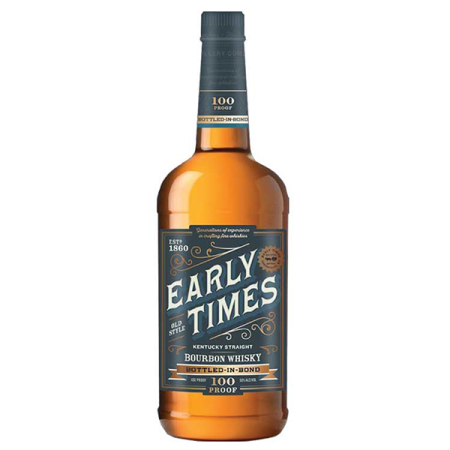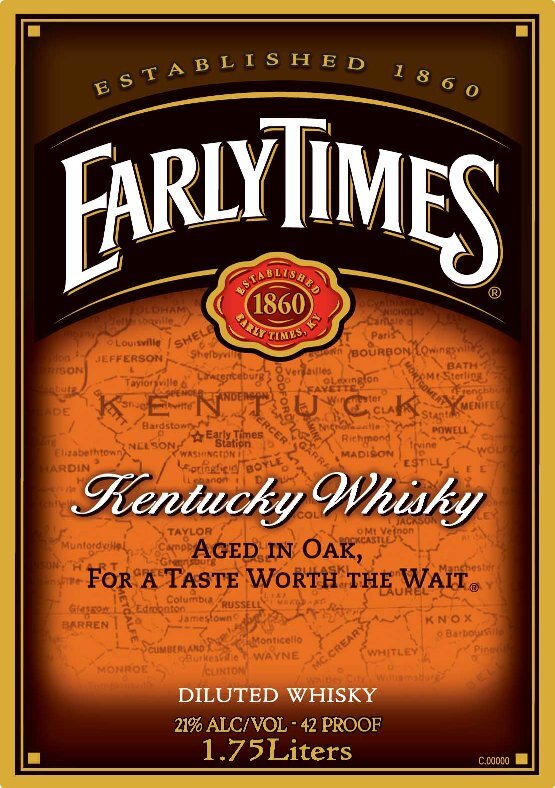Early Times: The Good, the Bad & the Ugly
Early Times bottled-in-bond Bourbon is a favorite value bottle of many Bourbon drinkers. A liter bottle for about $25 is tough to beat. The 80-proof Early Times “Old Style Kentucky Whisky”, on the other hand, isn’t something that garners too much buzz.
Last July, Early Times was sold by its long-time owner, Brown-Forman, to Sazerac. With the sale, there is some good news, bad news and, in my opinion, ugly news about the future of Early Times. Before we get to the future, however, let’s take a quick look at the past of this 160-year old brand.
Early Times History
Early Times was started by Jake Beam, Jim Beam’s uncle, in 1860. Jake died in 1915 and the distillery was closed at the onset of Prohibition. Brown-Forman bought the warehoused whiskey held by Early Times to be used for “medicinal purposes” during Prohibition. Following Prohibition, Brown-Forman re-launched the brand, and by the 1950s Early Times was the top-selling Bourbon in America.
As a cost-cutting move in 1983, Brown-Forman started storing some Early Times stock in used barrels. Therefore, it could no longer be classified as “Bourbon”. Brown-Forman called this non-Bourbon product “Old Style Kentucky Whisky”. This change to “whisky” is only necessary in American markets as foreign markets do not use the stock aged in used barrels and is still called “Bourbon”.
The move to a “whisky” in the U.S. created a drop in Early Times’ popularity, but it remained a favorite internationally. And, like the mythical rock band “Spinal Tap”, Early Times is especially popular in Japan.
In 2017, Brown-Forman gave us a limited-release Early Times bottled-in-bond product. Since then, Early Times BiB has experienced both an expanding distribution and popularity. The 80-proof “Old Style Kentucky Whisky” has continued to be produced all along.
The Good
Changes, such as the sale of a brand, create concern in Bourbon fans. The questions about such changes linger quite awhile before any answers arrive. Earlier this month, we finally received a few answer from Sazerac about their plans for Early Times. The whisky and the bottled-in-bond expression would both continue on under the new ownership. Early Times’ new home will be the Barton 1792 Distillery and production using the same mash bill (79% corn / 11% rye / 10% barley) will begin this summer. The survival of the bottled-in-bond Early Times following the sale was very good news, indeed.
The Bad
The “bad” could also be called the “unknown”, except there isn’t a Clint Eastwood movie called “The Good, the Unknown and the Ugly”. Sazerac has developed a reputation of introducing changes to its brands that aren’t exactly customer-friendly. In recent years, price hikes and increased allocation measures have been common in most any Sazerac brand worth drinking. Will the Early Times bottled-in-bond suffer the same fate?
In Sazerac’s April press release, brand manager Adam Wilkins said, “Sazerac will continue to deliver the same great tasting Early Times bottled-in-bond product consumers have grown to love using the original mashbill”. That sounds reassuring, but it also cannot be true. Simply having the same mashbill does not mean the taste of the bourbon will be the same. What about yeast, barrel entry proof or the impact of being in a different rickhouse? All of these things and more will change the flavor of Early Times. Will that be a bad thing? Nobody knows yet, of course, and won’t know for several years. If you are a fan of the Brown-Forman version of Early Times, however, I’d suggest you stock up.
The Ugly
Sazerac will be offering a new expression of Early Times that has not received any fanfare or announcement that I have seen from its new parent company. According to the TTB website, on April 1 of this year a label was approved for an Early Times diluted whisky. This will be released at 42 proof. Not 42% ABV. 42 proof. Hopefully, this is just an April Fools’ Day prank.
Diluted whisky has its own class (148) with the TTB. In the past five years only four other labels have been approved by the TTB in that class. So, why in a whiskey world where the public is demanding more and more higher-proof and barrel-strength bourbon do you go so dramatically the other way? Why do you offer a class of whisky that has been practically abandoned?
I asked a few friends their thoughts on this dilute whiskey offering. To summarize the collective response: “No”. Mike Lisac of My Whiskey Den offered “maybe this is a way to get rid of off-profile whiskey”. So, perhaps, they didn’t like some of the barrels they purchased and found it was easier and less expensive to water them down than finish them in a secondary barrel. Perhaps, Sazerac is trying to create a whisky offering that is a gateway from other lower-proof spirits to Bourbon. Hopefully, we get some answers in a press release from Sazerac on this sometime soon, but getting substantive answers is not usually how those things work.
The ultimate effect of the changes resulting from the sale of Early Times won’t be known for months and even years. In the end we’ll likely see some of these changes as good, some as bad and some as ugly. Thankfully the historic brand and the bottled-in-bond expression of it will go on.



